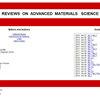用立体光刻技术制造的梯度三周期最小表面结构的能量吸收
IF 3.6
4区 材料科学
Q2 MATERIALS SCIENCE, MULTIDISCIPLINARY
引用次数: 0
摘要
三周期极小表面(TPMS)超材料具有天然材料中不常见的特殊性能。由于其表面几何形状和机械特性,TPMS 超材料可用于轻质结构和冲击能量吸收结构。本研究探讨了通过立体光刻技术制造的树脂基均质和梯度 TPMS 结构的准静态力学性能。实验和数值模拟结果表明,与均质 TPMS 结构相比,梯度 TPMS 结构具有更强的能量吸收能力。此外,通过改变 TPMS 相对密度和单元厚度的梯度变化区间,还能进一步提高梯度 TPMS 结构的优势。如果 TPMS 结构的 C 值函数的斜率和截距保持不变,选择电池的梯度方向与材料上的载荷方向一致的设计,可以增强 TPMS 结构的能量吸收能力。本文章由计算机程序翻译,如有差异,请以英文原文为准。
Energy absorption of gradient triply periodic minimal surface structure manufactured by stereolithography
Triply periodic minimal surface (TPMS) metamaterials possess exceptional properties not commonly found in natural materials. TPMS metamaterials are used in lightweight structures and impact energy absorption structures due to their surface geometry and mechanical properties. The quasi-static mechanic properties of resin-based homogeneous and gradient TPMS structures manufactured by stereolithography are investigated in this study. The results of both experimental and numerical simulations reveal that the gradient TPMS structures have superior energy absorption abilities compared to the homogeneous TPMS structures. Furthermore, the benefits of gradient TPMS structures can be further enhanced by changing the gradient variation interval of the relative density and cell thickness of TPMS. If the slope and intercept of the C value function of the TPMS structures remain constant, selecting a design where the gradient direction of the cell aligns with the direction of the load on the material can enhance the energy absorption capability of the TPMS structures.
求助全文
通过发布文献求助,成功后即可免费获取论文全文。
去求助
来源期刊

Reviews on Advanced Materials Science
工程技术-材料科学:综合
CiteScore
5.10
自引率
11.10%
发文量
43
审稿时长
3.5 months
期刊介绍:
Reviews on Advanced Materials Science is a fully peer-reviewed, open access, electronic journal that publishes significant, original and relevant works in the area of theoretical and experimental studies of advanced materials. The journal provides the readers with free, instant, and permanent access to all content worldwide; and the authors with extensive promotion of published articles, long-time preservation, language-correction services, no space constraints and immediate publication.
Reviews on Advanced Materials Science is listed inter alia by Clarivate Analytics (formerly Thomson Reuters) - Current Contents/Physical, Chemical, and Earth Sciences (CC/PC&ES), JCR and SCIE. Our standard policy requires each paper to be reviewed by at least two Referees and the peer-review process is single-blind.
 求助内容:
求助内容: 应助结果提醒方式:
应助结果提醒方式:


